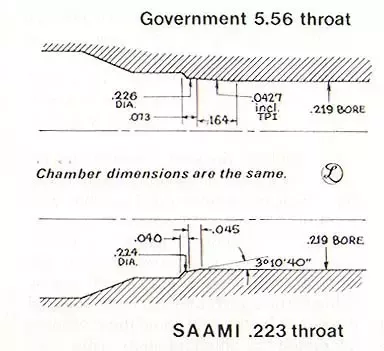1. The Chamber difference between .223 Remington and 5.56 NATO is the result of the 62 grain steel core round of 1980. This does not preclude the possibility of chamber differences between .223 Remington weapons and military weapons from prior to 1980, but I have not seen any evidence of this.
2. The M193 round was loaded to pressures at or below the pressure limits for .223 Remington during the entirety of it's history. I've seen nothing showing otherwise, nor have I seen anything suggesting that it's pressures were measured in a different chamber.
On Number one, that difference has to do with US (SAMMI) and European (CPI) standards groups coping with starting with two sets of preferences & pressure differences.
All of which dates back to the 60s and the SS1xx series of European standardized ammo, which significantly predates the "larger than 55gr" military projectiles.
DoD adopted the .223 remington "as is" under the internal designation of 5.56x45mm. Later, much later, actually, they adopted SS109 ammo as part of STANAG compliance with our own allies.
As heavier rounds, and penetrator core ammo was adopted--in the 80s, a generation, 20 years', into .223/5.56 development, the rounds have had all manner of adjustments to pressures and chamber fit tolerances. (Which is the "why" of Number two.)
All of this brouhaha is why the .233wylde was trotted out, it was meant to be "the great compromise" which erased the differences. But, the world largely ignored the Wylde, as the existing standards were "good enough." (There are issues in Europe, where Proof Houses are involved, in legally labeling and testing arms.)
As to reference sources, well, you'd need a séancé to ask Eugene Stoner, but Jim Sullivan is still around. And, he's pretty clear on this stuff, having seen it through.
As to trusting wiki, it might be germane to note that the qualifications to be a wiki editor are not that steep (and I am one) but their standards for actually editing articles is middling abysmal (I've tried to correct a number of them, with cross-referenced data and citations).
"Heavy" loadings and "longer loaded" bullets are generally civilian, not military, so they are more likely to be labeled ".223" as a general rule. Military loadings are meant to fit STANAG chambers, those scant thousandths
shorter.
Really, for Number Two, above, military ammo is often under-pressure in comparison to other rounds, and that's from having larger Standard Deviations in the Acceptance specifications. And for needing to be suitable in a huge range of potential weapons. NATO STANAG has to work in L85A3, HK 417, G36, FAMAS (for a while yet), M-4, M-16A
x, M-249, and a rather large number of AK variants for new NATO members like Poland.



